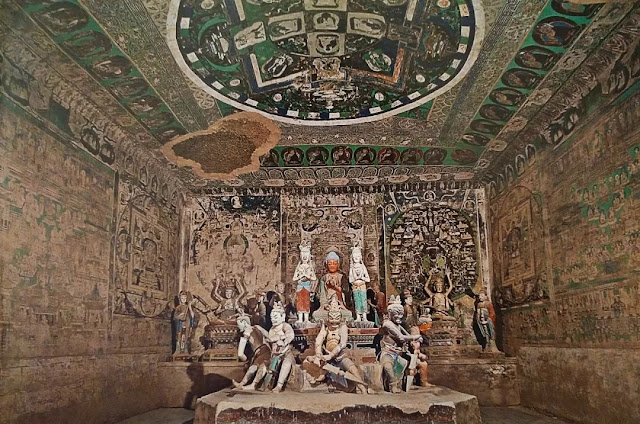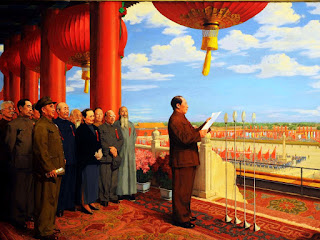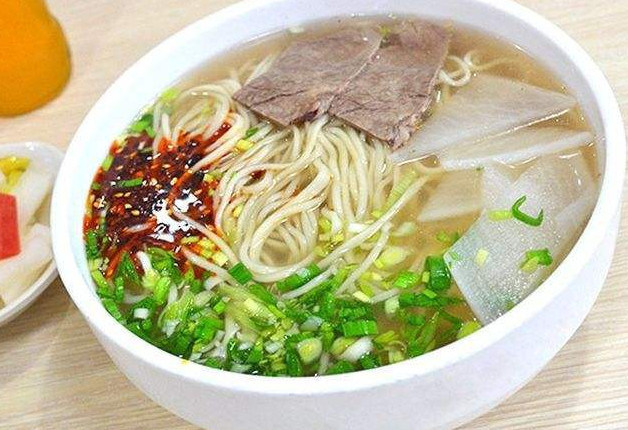See Chinese Grotto Art From The Top 8 Buddhist Grottoes
Grotto refers to the temples that are built on mountainside or cliffs. It originated in India, where the practice of Buddhist doctrines are affected by the damp and hot climate in the South Asian subcontinent. Therefore, the ancient Indians built their temples and meditation rooms in caves where the summer was cool, and spring was warm. Later, the practice was introduced to China together with Buddhism; Chinese Buddhist disciples learned from the master and continued to build grottoes and caves everywhere.
The excavation of the Chinese Buddhist grottoes started around the 3rd century (the Han Dynasty), became popular from the 5th to 8th centuries, and peaked in the Tang Dynasty (618 - 907). In the following times, the chiseling of caves continued but slowly until the 16th century (Ming Dynasty). It’s a process of learning, localization, and reforming a foreign art. The current grottoes are mainly scattered in Xinjiang (ancient western regions), western Gansu, Yellow River areas, and some parts of the Yangtze River regions. Here is a list of the top ten Buddhist Grottoes in China that can represent the development of grotto art.
- 1.Kilzil Thousand-Buddha Caves in Aksu
Situated in the Baicheng Town, Aksu Prefecture, the Kilzil Thousand-Buddha Caves are the earliest and the farthest large-scale grotto complex in western China. There are 236 numbered caves, in which 135 caves are complete, and 80 caves contain beautiful murals. The Kilzil Thousand-Buddha Caves give a full record of the social change in Aksu areas during the reign of the Kucha Kingdom (3rd century - 11th century).
Since the 3rd century (late Eastern Han dynasty), when the construction of the caves began, Buddhism was the national religion of Kucha Kingdom, and the Aksu areas were the Hinayana center. Therefore, Buddhist grotto art became popular and boomed during the 5th-7th century.
In 840, the Kucha Kingdom was integrated into the Uighur territory, and Buddhism began its downhill path. In the following two centuries, Buddhism was gradually abandoned when the Kucha court was forced to switch its suzerain multiple times and ultimately merged into the Karakhanid Empire at the end of the 11th century. Islamism boomed in Aksu regions, and the Kilzil Thousand-Buddhas Caves lost its position.
 |
| Kilzil Thousand-Buddha Caves |
- 2.Bezeklik Caves in Turpan
Located at the foot of the Flaming Mountain, 45km from the Turpan City (ancient Gaochang city), the Bezeklik Caves are one of the biggest Buddhist grotto sites that contain the wealthiest murals. There are 83 caves, and 40 of them have beautiful frescoes. The earliest caves, the Cave 18, 29, and 48, were excavated during the reign of Gaochang Kingdom (499 - 640), roughly the time of late the Northern and Southern Dynasties (420-589) in central China areas.
Later, the Gaochang Kingdom was taken into the great Tang Empire and the grotto arts at the time reflected the change as well. Cave 16, 17, 25, 27, 31, 42, and 69 bore the characteristics of Tang dynasty grottoes. With the Tang dynasty's decline, Uighur Gaochang (866 - 1283) was established, who continued to construct the Buddhist caves. Cave 14, 20, 31, 33, 39, 41, and 82 belonged to the period. The mural themes were more diversified and colorful. In the late 13th century, the Gaochang court migrated to Gansu, and Islamism was brought into Turpan, resulting in the Bezeklik Caves' desolation.
In the late Qing dynasty, the foreign powers came to Turpan and imposed great damage to the treasures in the Bezeklik Caves. Nevertheless, there are still some murals left to be appreciated.
 |
| Bezeklik Caves |
- 3.Yungang Grottoes in Datong
Yungang Grottoes are located on the south side of the Wuzhou Mountain, 17km west of Datong city, Shanxi province. They are one of the four most significant grotto treasure houses in China (the other three refers to Longmen Grottoes, Maijishan Grottoes, and Mogao Caves). There are 45 primary caves, 252 niches, and 51,000 Buddhist statues.
The history chronicles suggest that the Yungang Grottoes were built under the presiding of a famous monk named Tan Yao in the Northern Wei Dynasty (384 - 534). He took charge of making Cave 16, 17, 18, 19, and 20, the earliest five caves. In 494, Xiaowen Emperor of the Northern Wei Dynasty moved the capital from Pingcheng (today’s Datong) to Luoyang. The excavation of Yungang Grottoes gradually stopped. Therefore, most of the caves here are built in the 5th century.
The caves from different times bear different characteristics. The early caves built by Tan Yao were grand, plain, and simple. The middle-term grottoes were more sophisticated, decorative, and majestic, illustrating the unique art style in the Northern Wei dynasty. In contrast, the late-built grottoes were smaller, but the figures were slim and appropriately proportional, leading to the trend of “slim and skinny Buddhist statues” in northern Chinese grottoes art. Besides, the Yungang Grottoes also developed Chinese-style niches and temple buildings.
 |
| Yungang Grottoes |
- 4.Mogao Caves in Dunhuang
Mogao Caves, also called Thousand-Buddha Caves, are located in Dunhuang. They were initially built in the Former Qin period (350 -394) and renovated in Northern Dynasty, Sui, Tang, Five Dynasties, Xixia, and Yuan dynasties. Nowadays, there are 735 caves, 45,000 square meters of frescoes, and 2,415 colored clay figurines, making it the largest Buddhist grotto center.
The entire site is divided into southern and northern zones. The southern zone is the major body of the Mogao Caves. It has 487 caves that contain frescoes and Buddhist statues. Monks practiced here. While the northern area has 248 caves, and only 5 of them include frescoes and sculptures. The rest of the caves were where monks live and buried.
The caves are in different sizes, some are big, and some are small. The frescoes are mainly dedicated to telling Buddhist stories. There are also many beautiful colored figures of flying figures, birds, flowers, and animals that are still bright in color despite the long history.
 |
| Mogao Caves |
- 5.Yulin Grottoes in Guazhou
Yulin Grottoes are excavated on the cliffs of the Yulinhe Valley, 70km from Guazhou City. They are very similar to the Mogao Caves in terms of formation, content, and artistry style. People assume that they must be a branch of the Mogao art system. There is no written record proving when exactly the caves were built, but judging from the fresco styles and themes, some works were completed in Tang, Five Dynasties, Song, Xixia, Yuan, and Qing dynasties.
Forty-three caves contain intact murals; among them, 32 caves are located on the eastern cliff, and 11 caves are on the western cliff. There are 252 colored statues, which accounts for about 5,600 square meters. Although Yulin Grottoes is considered the sister cave of the Mogao Caves, they have different styles in many ways. There is an evident decline in Mogao Caves after the Five Dynasties Period (907 - 979). But Yulin Grottoes maintained its high-level art form and painting styles, supplementing the Mogao art system. Unfortunately, the initial colored statues were mostly damaged for both natural and human reasons. Therefore, the beautiful colored figures we see today were rebuilt in later times.
 |
| Yulin Grottoes |
- 6.Longmen Grottoes in Luoyang
Longmen Grottoes are located on the Longmen Mountain and Xiangshan Mountain, 13km from Luoyang. They are first built in 494 when Xiaowen Emperor of the Northern Wei Dynasty moved the capital from Datong to Luoyang. Later, more caves and grottoes were added in Eastern Wei, Western Wei, Northern Qi, Northern Zhou, Sui, Tang, and Northern Song dynasties. Therefore, 30% of the caves are excavated in the Northern Wei Dynasty, 60% of the caves are from the Tang Dynasty, and 10% from other eras.
Statistically, there are 2345 niches, 70 Buddhist pagodas, 2860 inscriptions, and 110,000 statues in Longmen Grottoes. The biggest statue, the statue of Vairocana Buddha, is 17m in height, and the smallest niche is only 2cm. The Longmen Twenty Works and the Stele of Yique Niche, written by Chu Suiliang, are the models of tablet script and regular script.
In terms of the styles, the statues from the Northern Wei dynasty are slim, lively, delicate, and mild. In comparison, the Tang dynasty statues are plump, mellow, and clement.
 |
| Longmen Grottoes |
- 7.Maijishan Grottoes
Majishan Grottoes are located on the Maiji Mountain, 40km from Tianshui city. They are first built in the Later Qin dynasty (384-417), and the construction boomed in the Northern Wei Dynasty. Therefore, in the 194 grottoes discovered here, 140 caves were from Western Qin, Northern Wei, and Western Wei dynasties. Only 54 caves were excavated in Northern Zhou, Sui, Tang, and later times. In 734 (Kaiyuan Era of the Tang Dynasty), an earthquake shook the Maiji Mountain, dividing the complex into the eastern and western cliffs.
On the western cliff, there are 7,800 statues, including clay figures, stone core statues, stone statues, and over 1,000 frescoes. The biggest Buddha statue is 15.8m in height. The eastern cliff is famous for the embossed stone pillars in front of the Nirvana Cave, the 258 neatly arranged Buddha statues on the Thousand-Buddha Corridor, and the exquisite Seven-Buddha Pavilion.
 |
| Maijishan Grottoes |
- 8.Binglingsi Grottoes
Binglingsi Grottoes are located in the Dasi valley of Yongjing county, Linxia Hui Autonomous Prefecture. They were first built in 420 (Former Qin Dynasty) and added in the Northern Wei, Tang, and Ming dynasties. There are 216 caves in existence, 776 stone carved statues, over 1000 frescoes, four cliff steles, and six inscriptions.
Caves 169, 192, and 195 were built in the Western Qin dynasty. The Ink Preface preserved in Cave 169 is the earliest of its kind in China, offering a standard for the periodization of early grottoes. The Caves 126, 128, and 132 represented the works from the Northern Wei Dynasty, characterized by skinny bodies, full robes, and wide belts. The 135 Tang dynasty caves account for the majority of the caves. In Cave 171, a 27m-high Statue of Maitreya Buddha sits cross-legged on a square platform that fully represents the statue attributes of the Tang dynasty. In contrast, the Buddhist story painting and Yuan dynasty Eight-armed Avalokitesvara in Cave 3 represent the works from the Yuan Dynasty. The Eight-armed Avalokitesvara in the Cave 168 and the Woodcut Nirvana in the Cave 172 are the representatives from the Ming Dynasty.
 |
| Binglingsi Grottoes |
Plan a Grotto Trip? Check the Following Itineraries as Reference:
8 Days In-depth Silk Road Culture Tour to Dunhuang and Zhangye
8-day Xinjiang Tour to Urumqi, Turpan and Kashgar5 Days Xian and Luoyang Heritage Tour




Comments
Post a Comment